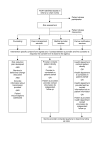A novel emergency department based prevention intervention program for people living with HIV: evaluation of early experiences
- PMID: 17937817
- PMCID: PMC2194768
- DOI: 10.1186/1472-6963-7-164
A novel emergency department based prevention intervention program for people living with HIV: evaluation of early experiences
Abstract
Background: HIV prevention is increasingly focused on people living with HIV (PLWH) and the role of healthcare settings in prevention. Emergency Departments (EDs) frequently care for PLWH, but do not typically endorse a prevention mission. We conducted a pilot exploratory evaluation of the first reported ED program to address the prevention needs of PLWH.
Methods: This retrospective observational cohort evaluation reviewed program records to describe the first six months of participants and programmatic operation. Trained counselors provided a risk assessment and counseling intervention combined with three linkage interventions: i) linkage to health care, ii) linkage to case management, and iii) linkage to partner counseling and referral.
Results: Of 81 self-identified PLWH who were approached, 55 initially agreed to participate. Of those completing risk assessment, 17/53 (32%, 95 CI 20% to 46%) reported unprotected anal/vaginal intercourse or needle sharing in the past six months with a partner presumed to be HIV negative. Counseling was provided to 52/53 (98%). For those requesting services, 11/15 (73%) were linked to healthcare, 4/23 (17%) were coordinated with case management, and 1/4 (25%) completed partner counseling and referral.
Conclusion: Given base resources of trained counselors, it was feasible to implement a program to address the prevention needs for persons living with HIV in an urban ED. ED patients with HIV often have unmet needs which might be addressed by improved linkage with existing community resources. Healthcare and prevention barriers for PLWH may be attenuated if EDs were to incorporate CDC recommended prevention measures for healthcare providers.
Figures
Similar articles
-
Preliminary program evaluation of emergency department HIV prevention counseling.Ann Emerg Med. 2011 Jul;58(1 Suppl 1):S120-5.e1-3. doi: 10.1016/j.annemergmed.2011.03.036. Ann Emerg Med. 2011. PMID: 21684390 Free PMC article.
-
Clinical and behavioral characteristics of adults receiving medical care for HIV infection --- Medical Monitoring Project, United States, 2007.MMWR Surveill Summ. 2011 Sep 2;60(11):1-20. MMWR Surveill Summ. 2011. PMID: 21881551
-
HIV infection and risk, prevention, and testing behaviors among injecting drug users -- National HIV Behavioral Surveillance System, 20 U.S. cities, 2009.MMWR Surveill Summ. 2014 Jul 4;63(6):1-51. MMWR Surveill Summ. 2014. PMID: 24990587
-
Partner notification for HIV prevention: a critical reexamination.AIDS Educ Prev. 1997 Jun;9(3 Suppl):68-78. AIDS Educ Prev. 1997. PMID: 9241399 Review.
-
Prevention Interventions for People Living with HIV in Military Settings.Curr HIV Res. 2017;15(2):90-94. doi: 10.2174/1570162X15666170516165331. Curr HIV Res. 2017. PMID: 28176645 Review.
Cited by
-
HIV Care Continuum for HIV-Infected Emergency Department Patients in an Inner-City Academic Emergency Department.Ann Emerg Med. 2015 Jul;66(1):69-78. doi: 10.1016/j.annemergmed.2015.01.001. Epub 2015 Feb 23. Ann Emerg Med. 2015. PMID: 25720801 Free PMC article.
-
Seroprevalence of HIV infection among the patients attending various emergency departments in a tertiary care hospital.Indian J Sex Transm Dis AIDS. 2010 Jan;31(1):27-9. doi: 10.4103/0253-7184.68997. Indian J Sex Transm Dis AIDS. 2010. PMID: 21808433 Free PMC article.
-
Improvements in the continuum of HIV care in an inner-city emergency department.AIDS. 2016 Jan 2;30(1):113-20. doi: 10.1097/QAD.0000000000000896. AIDS. 2016. PMID: 26731757 Free PMC article.
-
Moving Beyond Screening: How Emergency Departments Can Help Extinguish the HIV/AIDS Epidemic.West J Emerg Med. 2016 Mar;17(2):135-8. doi: 10.5811/westjem.2016.1.29100. Epub 2016 Mar 2. West J Emerg Med. 2016. PMID: 26973737 Free PMC article.
References
-
- Marks G, Crepaz N, Senterfitt JW, Janssen RS. Meta-analysis of high-risk sexual behavior in persons aware and unaware they are infected with HIV in the United States: implications for HIV prevention programs. J Acquir Immune Defic Syndr. 2005;39:446–453. doi: 10.1097/01.qai.0000151079.33935.79. - DOI - PubMed
Publication types
MeSH terms
Grants and funding
LinkOut - more resources
Full Text Sources
Medical
Miscellaneous


